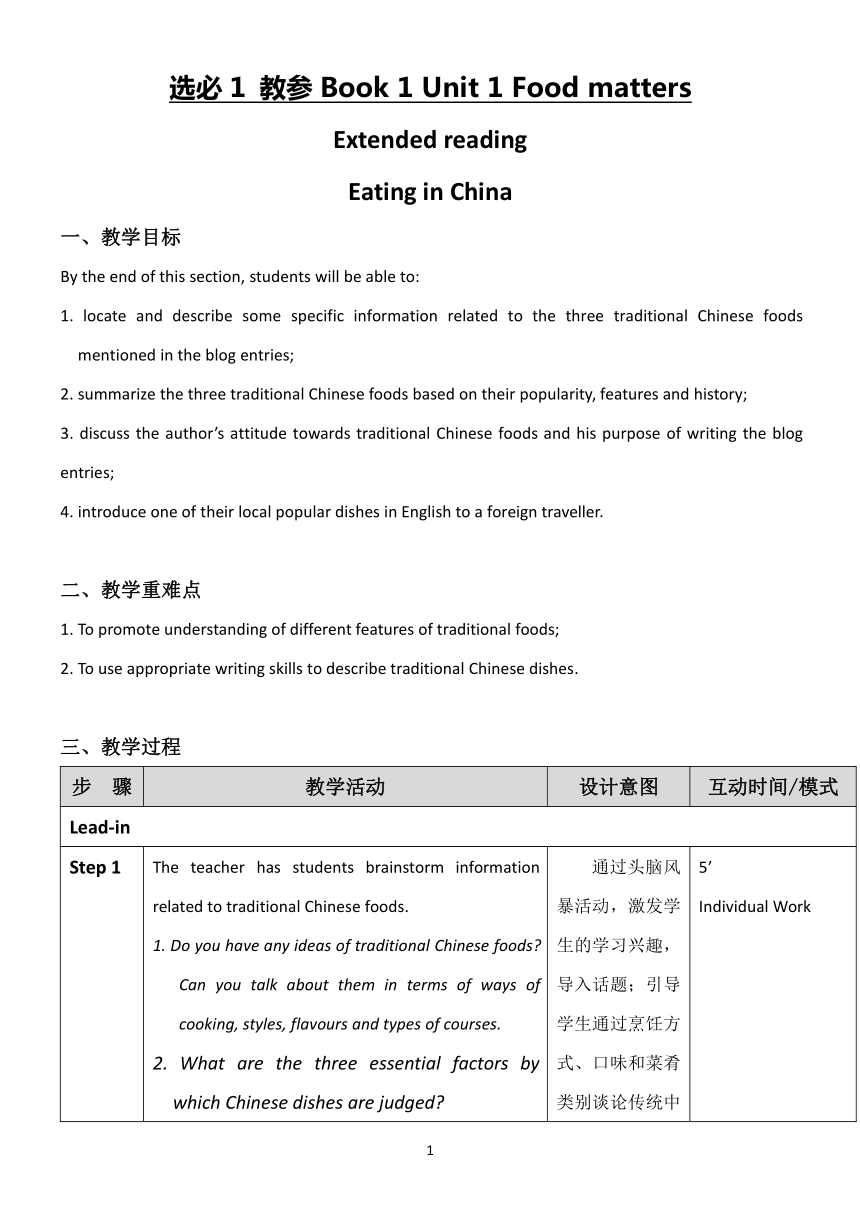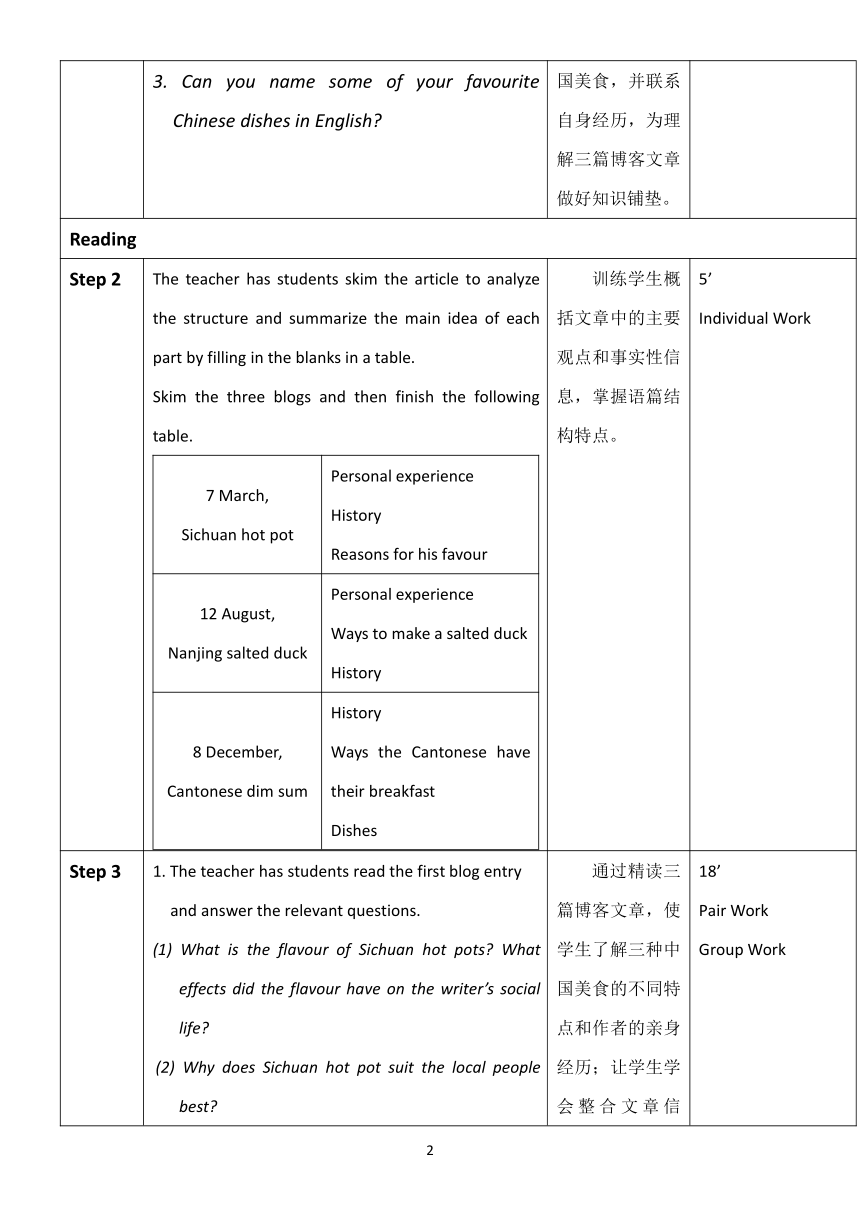牛津译林版(2019)选择性必修 第一册Unit 1 Food matters Extended reading教案(表格式)
文档属性
| 名称 | 牛津译林版(2019)选择性必修 第一册Unit 1 Food matters Extended reading教案(表格式) |  | |
| 格式 | doc | ||
| 文件大小 | 36.7KB | ||
| 资源类型 | 教案 | ||
| 版本资源 | 牛津译林版(2019) | ||
| 科目 | 英语 | ||
| 更新时间 | 2024-03-04 09:35:41 | ||
图片预览


文档简介
选必1 教参Book 1 Unit 1 Food matters
Extended reading
Eating in China
一、教学目标
By the end of this section, students will be able to:
1. locate and describe some specific information related to the three traditional Chinese foods mentioned in the blog entries;
2. summarize the three traditional Chinese foods based on their popularity, features and history;
3. discuss the author’s attitude towards traditional Chinese foods and his purpose of writing the blog entries;
4. introduce one of their local popular dishes in English to a foreign traveller.
二、教学重难点
1. To promote understanding of different features of traditional foods;
2. To use appropriate writing skills to describe traditional Chinese dishes.
三、教学过程
步 骤 教学活动 设计意图 互动时间/模式
Lead-in
Step 1 The teacher has students brainstorm information related to traditional Chinese foods.1. Do you have any ideas of traditional Chinese foods Can you talk about them in terms of ways of cooking, styles, flavours and types of courses.2. What are the three essential factors by which Chinese dishes are judged 3. Can you name some of your favourite Chinese dishes in English 通过头脑风暴活动,激发学生的学习兴趣,导入话题;引导学生通过烹饪方式、口味和菜肴类别谈论传统中国美食,并联系自身经历,为理解三篇博客文章做好知识铺垫。 5’Individual Work
Reading
Step 2 The teacher has students skim the article to analyze the structure and summarize the main idea of each part by filling in the blanks in a table. Skim the three blogs and then finish the following table.7 March,Sichuan hot potPersonal experienceHistoryReasons for his favour12 August,Nanjing salted duckPersonal experienceWays to make a salted duckHistory8 December, Cantonese dim sumHistoryWays the Cantonese have their breakfastDishes 训练学生概括文章中的主要观点和事实性信息,掌握语篇结构特点。 5’Individual Work
Step 3 1. The teacher has students read the first blog entry and answer the relevant questions.(1) What is the flavour of Sichuan hot pots What effects did the flavour have on the writer’s social life (2) Why does Sichuan hot pot suit the local people best (3) When did Sichuan hot pots originate from (4) What does the writer love the most about Sichuan hot pots 2. The teacher has the students read the first paragraph of the second blog entry and list the features of Nanjing salted duck from three aspects: appearance, time to prepare and process.3. The teacher has the students read the second paragraph and list the reasons for the popularity of Nanjing salted duck. 4. The teacher asks the students to read the third blog entry and complete the missing information in the table. 通过精读三篇博客文章,使学生了解三种中国美食的不同特点和作者的亲身经历;让学生学会整合文章信息,梳理文章中所描述的美食元素,包括历史渊源、在当地受欢迎的原因以及做法等。 18’Pair WorkGroup Work
Appreciation
Step 4 1. The teacher has the students explore the writing skills used in each blog entry. Students are asked to think about the reasons why the writer bases his writing on his personal experiences when introducing the dishes. Why does the writer base his writing on his personal experiences when introducing the traditional foods 2. The teacher has the students search for adjectives used by the author when it comes to the description of the foods and try to explain the effects that those adjectives create. 指导学生探索三篇博客文章中的写作技巧。首先让学生讨论为什么作者在每篇博文中都会从个人经历入手介绍中国特色美食,从而使学生了解写作中联系个人经历有助于提高文本的可信度和说服力。其次,让学生找出作者描述食物时使用的不同形容词,学习这些形容词并运用于自己的写作中。 8’Group Work
Discussion
Step 5 The teacher has the students have a discussion on a popular local food. Students are required to introduce the food in terms of three aspects: popularity, history and features.What dish is popular in your hometown Introduce it to a foreign traveller. Explain its popularity, history and features. 通过鼓励学生用英文介绍家乡的特色美食,加深学生对源远流长的中华美食文化的认识,激发学生的民族自豪感,增强他们弘扬中国传统文化的使命感和责任感。 7’Group work
HomeworkPrepare a speech about traditional Chinese foods with several specific examples. 2’
Extended reading
Eating in China
一、教学目标
By the end of this section, students will be able to:
1. locate and describe some specific information related to the three traditional Chinese foods mentioned in the blog entries;
2. summarize the three traditional Chinese foods based on their popularity, features and history;
3. discuss the author’s attitude towards traditional Chinese foods and his purpose of writing the blog entries;
4. introduce one of their local popular dishes in English to a foreign traveller.
二、教学重难点
1. To promote understanding of different features of traditional foods;
2. To use appropriate writing skills to describe traditional Chinese dishes.
三、教学过程
步 骤 教学活动 设计意图 互动时间/模式
Lead-in
Step 1 The teacher has students brainstorm information related to traditional Chinese foods.1. Do you have any ideas of traditional Chinese foods Can you talk about them in terms of ways of cooking, styles, flavours and types of courses.2. What are the three essential factors by which Chinese dishes are judged 3. Can you name some of your favourite Chinese dishes in English 通过头脑风暴活动,激发学生的学习兴趣,导入话题;引导学生通过烹饪方式、口味和菜肴类别谈论传统中国美食,并联系自身经历,为理解三篇博客文章做好知识铺垫。 5’Individual Work
Reading
Step 2 The teacher has students skim the article to analyze the structure and summarize the main idea of each part by filling in the blanks in a table. Skim the three blogs and then finish the following table.7 March,Sichuan hot potPersonal experienceHistoryReasons for his favour12 August,Nanjing salted duckPersonal experienceWays to make a salted duckHistory8 December, Cantonese dim sumHistoryWays the Cantonese have their breakfastDishes 训练学生概括文章中的主要观点和事实性信息,掌握语篇结构特点。 5’Individual Work
Step 3 1. The teacher has students read the first blog entry and answer the relevant questions.(1) What is the flavour of Sichuan hot pots What effects did the flavour have on the writer’s social life (2) Why does Sichuan hot pot suit the local people best (3) When did Sichuan hot pots originate from (4) What does the writer love the most about Sichuan hot pots 2. The teacher has the students read the first paragraph of the second blog entry and list the features of Nanjing salted duck from three aspects: appearance, time to prepare and process.3. The teacher has the students read the second paragraph and list the reasons for the popularity of Nanjing salted duck. 4. The teacher asks the students to read the third blog entry and complete the missing information in the table. 通过精读三篇博客文章,使学生了解三种中国美食的不同特点和作者的亲身经历;让学生学会整合文章信息,梳理文章中所描述的美食元素,包括历史渊源、在当地受欢迎的原因以及做法等。 18’Pair WorkGroup Work
Appreciation
Step 4 1. The teacher has the students explore the writing skills used in each blog entry. Students are asked to think about the reasons why the writer bases his writing on his personal experiences when introducing the dishes. Why does the writer base his writing on his personal experiences when introducing the traditional foods 2. The teacher has the students search for adjectives used by the author when it comes to the description of the foods and try to explain the effects that those adjectives create. 指导学生探索三篇博客文章中的写作技巧。首先让学生讨论为什么作者在每篇博文中都会从个人经历入手介绍中国特色美食,从而使学生了解写作中联系个人经历有助于提高文本的可信度和说服力。其次,让学生找出作者描述食物时使用的不同形容词,学习这些形容词并运用于自己的写作中。 8’Group Work
Discussion
Step 5 The teacher has the students have a discussion on a popular local food. Students are required to introduce the food in terms of three aspects: popularity, history and features.What dish is popular in your hometown Introduce it to a foreign traveller. Explain its popularity, history and features. 通过鼓励学生用英文介绍家乡的特色美食,加深学生对源远流长的中华美食文化的认识,激发学生的民族自豪感,增强他们弘扬中国传统文化的使命感和责任感。 7’Group work
HomeworkPrepare a speech about traditional Chinese foods with several specific examples. 2’
同课章节目录
- Unit 1 Food matters
- Welcome to the unit
- Reading
- Grammar and usage
- Integrated skills
- Extended reading
- Project
- Unit 2 The Universal Language
- Welcome to the unit
- Reading
- Grammar and usage
- Integrated skills
- Extended reading
- Project
- Unit 3 The art of painting
- Welcome to the unit
- Reading
- Grammar and usage
- Integrated skills
- Extended reading
- Project
- Unit 4 Exploring poetry
- Welcome to the unit
- Reading
- Grammar and usage
- Integrated skills
- Extended reading
- Project
